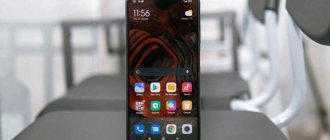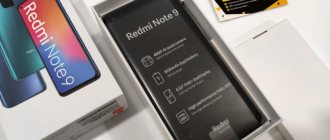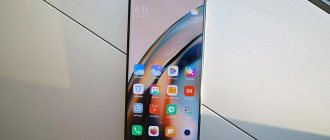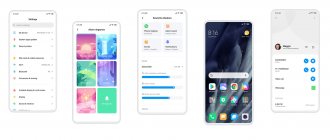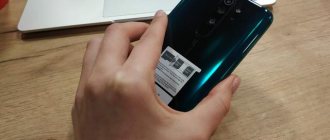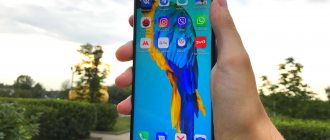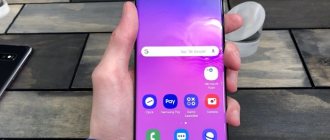Xiaomi has created a budget Redmi line for less demanding customers. However, it soon became clear that the Redmi Note series is capable of satisfying even more demanding people, offering quite a lot at an attractive price. I recently checked how the new Redmi Note 8 Pro will perform in practice, in a configuration of 6 GB of RAM, 64 GB of internal memory.
Today, mini headphone jacks and memory card slots have begun to disappear from high-end smartphones. But we will still find them in Redmi Note models, as well as a capacious battery, good optics with high quality workmanship. The only thing that was still missing was an NFC module. In our country, the mobile payment market is developing rapidly, so many people abandoned Redmi phones because they did not support contactless payments. However, Xiaomi finally noticed the needs of the market, and Redmi Note 8 Pro was equipped with NFC. The device also received a large battery, a headphone jack and a slot for SIM and memory cards. The main camera sensor is an impressive 64MP, which is larger than flagship phones.
You can buy Redmi Note 8 Pro 6/64 on AliExpress
You can buy Redmi Note 8 Pro 6/128 on AliExpress
It sounds very tempting from a marketing point of view, but, as you know, the quality of photographs is determined not only by the number of pixels. The processor may cause a little concern - since it is from the Taiwanese division of MediaTek, and not the American Qualcomm. This is the Helio G90T, which on paper and in tests is comparable in efficiency to the Snapdragon 730. So, enough chatter, let's move on to the review...
Redmi Note 8 Pro specs comparison
| Peculiarity | Redmi Note 8 Pro | Redmi Note 7 Pro | Redmi Note 8 | Redmi Note 7 |
| Display | 6.53-inch IPS resolution 1080×2340 | 6.3-inch IPS resolution 1080×2340 | 6.3-inch IPS resolution 1080×2340 | 6.3-inch IPS resolution 1080×2340 |
| CPU | MediaTek Helio G90T | Qualcomm Snapdragon 675 | Qualcomm Snapdragon 665 | Qualcomm Snapdragon 660 |
| Graphic arts | Mali-G76 MP4 | Adreno 612 | Adreno 610 | Adreno 512 |
| RAM | 6/8 GB | 4/6 GB | 4/6 GB | 3/4 GB |
| ROM | 64/128 GB, microSD memory card slot | 64/128 GB, microSD memory card slot | 64/128 GB, microSD memory card slot | 32/64 GB, microSD memory card slot |
| Main camera | Quad, 64MP main lens + 8MP wide + 2MP depth + 2MP macro | Dual module, main lens 48-MP + 5-MP depth | Quad, main lens 48-MP + 8-MP wide + 2-MP depth + 2-MP macro | Dual module, main lens 48-MP + 5-MP depth |
| Front camera | 20-MP | 13-MP | 13-MP | 13-MP |
| Battery | 4500 mAh, 18W fast charging | 4000 mAh, 18W fast charging | 4000 mAh, 18W fast charging | 4000 mAh, 18W fast charging |
| Biometrics | Rear fingerprint scanner | Rear fingerprint scanner | Rear fingerprint scanner | Rear fingerprint scanner |
| BY | MIUI 10 | MIUI 10 | MIUI 10 | MIUI 10 |
Screen
The display diagonal in the Note 8 Pro has increased from 6.3 to 6.53 inches, it is slightly more elongated and has thinner frames: the thickness of the top is only 2 mm, the bottom is 4 mm. The screens are very similar in color rendering. An absolutely adequate IPS matrix with FullHD+ resolution is used, demonstrating a pleasant picture with a good level of contrast and normal black color. In terms of white balance, the screen is a little cold, but MIUI allows you to adjust the color temperature at your discretion.
Multi-touch works clearly, there is oleophobia - your finger glides across the screen without any problems. The settings include a dark theme (works across the entire interface and in compatible applications), a reading mode, and a double-tap function to wake up the screen. Auto-brightness and proximity sensor work surprisingly adequately in the sample we are testing.
The only thing I can complain about is the maximum brightness reserve. The RN8 Pro is inferior to mid-budget A-series Samsungs with AMOLEDs, but the problem is not critical, and you can use the phone on the street quite comfortably.
Design and appearance
The Redmi Note 8 Pro phone can hardly be called original, but its design is also difficult to accuse of banality. Stylistic changes are noticeable compared to its predecessor, Redmi Note 7. This mainly applies to the rear - the cameras have been moved from left to center, which is reminiscent of the solutions in the Mi 9T and Mi 9T Pro. Just below is a small fingerprint scanner.
Stylistically, everything looks very nice, but at first I had doubts about practicality. I wasn't sure if I would accidentally touch the camera lens with my finger. As it turned out, my doubts were unfounded. Firstly, the reader is placed in the right place, so it is easy to feel. Secondly, my finger always lay on it. Unfortunately, the lens and scanner module protrudes significantly above the main surface. And even if we put on the case that is included in the kit, it will still be subject to scratches when touching surfaces.
The side frames of the Note 8 Pro are made of plastic, and the back and front of the phone are covered with Gorilla Glass 5. There is an infrared LED on the top edge, so we can easily turn the smartphone into a remote control for home devices. There is also a corresponding Pilot Mi application for this. On the left side there is a hybrid tray for two SIM cards. On the bottom edge there is a 3.5 mm headphone jack, a USB-C port and a speaker. The left edge is occupied by two buttons - power and volume control.
The back panel of the device is slightly rounded on the sides, which, despite its large size, fits well in the hand, although, of course, the glass coating is very slippery. This ailment can be cured by putting on a case, but then the device loses most of its charm. The smartphone dimensions are 161.30 x 76.40 x 8.79 mm and weighs 199.80 g.
Cameras: high quality and honest, even at night
Xiaomi didn’t look at Samsung with its mouth open for long and very quickly adopted one of the main features of its latest low-cost smartphones. We are talking about a quad camera , which is now also available in the public sector phones of the Chinese brand. It is precisely because the smartphone has four cameras that you need to understand them thoroughly.
First, let's talk about what we're dealing with. In the photo arsenal of Redmi Note 8T:
- 48-megapixel camera with a six-element lens with f/1.79 aperture, 1.6 micron pixel size.
- 8-megapixel ultra-wide-angle camera (120°) with f/2.2 aperture, 1.12 micron pixel size.
- 2MP depth camera with f/2.4 aperture, 1.75µm pixel size.
- 2 megapixel macro camera with f/2.4 aperture, 1.75 micron pixel size.
The main 48-megapixel module is a Samsung S5KGM1 . This, for example, is installed in the Samsung Galaxy S10 Lite and Samsung Galaxy A90, which are much more expensive models. Some manufacturers, such as Lenovo, are pushing this camera into their flagship solutions, for example, Lenovo Z6.
In other words, the camera choice seems excellent for such an affordable smartphone. Perhaps the only thing that can ruin the shooting situation is crooked optimization, which Xiaomi is by no means famous for.
I thoroughly tested the Redmi Note 8T camera in various conditions and modes. This is what happened.
Note: all photos are clickable.
Examples of photos on Redmi Note 8T
Daytime shooting
The Redmi Note 8T copes well with daytime shooting. The images have great detail throughout the frame - look at the far end of the building. The color rendition is correct, without embellishment. By the way, this is especially clearly visible in this frame. There is not enough natural light here. However, the camera did not colorize the image to obtain a more colorful result, as is often the case.
The picture also shows the first jamb of the camera. Look at the people. They were moving at the usual speed of pedestrians, but they were already washed out.
A shot from the same angle, but at ultra-wide. The quality is comparable to photos taken with the main camera: high detail and honest color rendition have not gone away. I liked that when shooting with the ultra-wide-angle camera, the smartphone does not lag and takes photos instantly.
Two more examples of photos taken with the main and ultra-wide-angle cameras to consolidate the result. Here we managed to catch more natural light, so the detail increased. True, the dark places are poorly processed. In addition, chromatic aberrations are observed on background objects, for example, on the dome of a temple.
The wide-angle shot takes on all the pros and cons of the regular shot. I was pleased that the edges of the frame were practically not distorted. I admit, I didn’t expect to see this on the inexpensive Redmi.
The camera handles close-ups well, even when there isn't enough direct natural light, as in the example above. Of course, there is a lack of light - the curves would ideally be tightened up programmatically.
A good example of taking a closer look at a subject. I note that in all frames, in general, there is a lack of contour sharpness.
Evening shooting
Redmi Note 8T is an inexpensive smartphone, but when the sun goes down, it doesn't lose its photographic capabilities. In the evening you can really take good, eye-catching pictures. Local night mode, of course, will not allow you to photograph very far from artificial lighting. But if you choose the lighting well, you will get decent shots. There is no detail in the background, but the foreground is finely detailed.
A smartphone is great for shooting New Year's illumination. I am especially pleased with the correct color rendition.
However, no one canceled the noise in the evening photos. They will be, sometimes quite distinct.
Night photography
You can also get decent shots on the Redmi Note 8T in low light conditions. The main thing is to cling to any more or less bright object. In this case, you will get an acceptable photo. Note the absence of obvious visible noise and artifacts. Here they really tried.
The local night mode works in software terms as an improved HDR. This is confirmed by photographs taken at night. There is a complete absence of noise in the photo, which is why the frame even on a budget smartphone turns out to be more or less attractive. This was achieved by shooting at low ISO.
Another good example of a photo, but with greater light sensitivity. You can see how much more detailed the high-rise buildings have become, but noise has also appeared in the sky. The reality is that for high-quality photos in the evening and at night you will have to balance the light sensitivity in order to get high-quality photos. Or do it like everyone else - just save and save all the photos in automatic night mode, which is actually the best option.
Shooting video
Redmi Note 8T is capable of shooting video in 4K resolution. It sounds impressive, but in reality, you can only shoot a high-quality video for later viewing in comfort or publishing on YouTube in greenhouse conditions. And we’re not talking here about the quality of the picture, it’s quite okay.
Smartphone microphones are incredibly sensitive. Because of this, even in not the strongest wind, the video sounds like some kind of wild hurricane. I specifically looked at video samples from my colleagues’ reviews - the same problem. It's a shame, because in fact the video is of good quality.
At night, video detail drops significantly. Added to this is periodic defocus, and the microphones continue to howl.
What do I think about the display?
The IPS screen of the Xiaomi Redmi Note 8 Pro has increased slightly compared to its predecessor. Now we have a diagonal of 6.5 instead of 6.3 inches, which with the same resolution (2340x1080) results in fewer pixels per inch - 395 instead of 409. However, it is still very good, since the display additionally supports HDR.
Of course, readability will be better in the fall than in the summer - because maximum brightness in the sun is not the strong point of all IPS matrices. Luckily, there are no lighting issues at the bottom or top edge. If you look at the Note 8 Pro's screen at an angle, there's a slight drop in color. This can be improved by choosing from three settings (default, warm, cool) and automatic, high or standard contrast. In the settings you will also find a reading mode.
At the top of the front panel we have a small teardrop-shaped cutout in which the selfie camera and notification LED are hidden. Notifications appear to the left of it, and not for a moment, but until we delete them. This is a big improvement compared to the previous device in the series.
European version EU
| Firmware number | release date | Android | Recovery | OTA | Fastboot |
| MIUI 12 | 12.0.2.0.QCOEUXM | December 17, 2020 | 10 | Download | |
| MIUI 12 | 12.0.3.0.QCOEUXM | January 19, 2021 | 10 | Download | Download |
| MIUI 12 | 12.0.4.0.QCOEUXM | March 8, 2021 | 10 | Download | Download for |
| MIUI 12 | 12.0.6.0.QCOEUXM | April 19, 2021 | 10 | Download | Download |
| MIUI 12 | 12.0.3.0.RCOEUXM | August 23, 2021 | 11 | Download | Download for |
| MIUI 12 | 12.0.4.0.RCOEUXM | October 25, 2021 | 11 | Download | Download for |
Four cameras Redmi Note 8 Pro
The Redmi Note 8 Pro smartphone has four cameras on the rear panel, which, in principle, has never happened before in this price range. One of the lenses is used for depth determination, the other for macro photography (each 2-megapixel). In addition, we have a 64MP Samsung primary lens with an aperture of 1.9 and an 8MP ultra-wide lens. There is no telephoto lens when zooming in digitally.
Photos from the main lens are saved at 16MP resolution, although we can select 64MP in the camera app. They are a little more detailed, but the difference is small. Slow motion (960 frames per second), short video mode, portrait, night mode, panorama and Pro are also available. At the top you can enable LED mode, HDR mode, AI (artificial intelligence), macro mode, filters and beauty mode.
There are many possibilities, the question is: what quality are the photos? Photos from the main camera taken in good to medium lighting look very accurate. We have a lot of detail, pleasant sharpness, natural, desaturated colors (although sometimes you want more richness) and excellent contrast. I can't fault the automatic HDR either - it draws shadows perfectly.
Photo quality deteriorates when switching to wide-angle mode. Here, upon closer inspection, we will notice a decrease in detail, especially around the edges of the frames, even in good lighting. However, these photos are great for social media, and deserve praise for maintaining colors that are almost identical to those from the main camera.
The digital zoom in the Note 8 Pro works well, which is certainly due to the high resolution of the main sensor. Night photos with longer exposure times also turn out quite good for this price class. A macro lens allows you to get very close to the photographed object, but the pictures come out average and usually soft. The portrait mode is also very good here.
Videos can be shot in 4K and FHD at 30/60 FPS or lower. Electronic image stabilization works in FHD resolution, but not in 4K. Overall, you can take very good photos with the new Redmi Note Pro, I'm happy with everything here.
Chinese version CN
| Firmware number | release date | Android | Recovery | OTA | Fastboot |
| MIUI 12 | 12.0.2.0.QCOCNXM | September 30, 2020 | 10 | Download | |
| MIUI 12 | 12.0.3.0.QCOCNXM | November 23, 2020 | 10 | Download | Download for |
| MIUI 12 | 12.0.1.0.RCOCNXM | February 20, 2021 | 11 | Download | |
| MIUI 12 | 12.0.3.0.RCOCNXM | June 1, 2021 | 11 | Download | Download for |
| MIUI 12.5 | 12.5.1.0.RCOCNXM | August 16, 2021 | 11 | Download | |
| MIUI 12.5 | 12.5.2.0.RCOCNXM | September 28, 2021 | 11 | Download | |
| MIUI 12.5 | 12.5.3.0.RCOCNXM | October 21, 2021 | 11 | Download | Download for |
System and software
Redmi Note 8 Pro comes with Android 9 OS version and MIUI 10.4.2. I have described the wide capabilities of this interface many times, so I will not focus too much on it. A nice addition is the ability to enable “dark mode”, in which the configured data is displayed on a black background of a sleeping smartphone.
We can also clone applications, block access to them, create a business or private space. We also have gestures (from the side edges) that replace the traditional system buttons displayed on the screen. Double tapping will wake up the screen, and a widget is available to clear it, so we hardly have to reach for the power button. In the settings there is a “Digital Balance”, where you can track data about the method and time of use of the phone.
A big plus is the improved display of notifications - you no longer have to drag the top bar to see what happened. Unfortunately, the downside is speed - using two phones at the same time, I noticed that notifications on the Note 8 Pro, for example from YouTube or Facebook, arrived a few minutes later than on the other device. Neither adding selected applications to autorun nor saving them in the battery settings as working without restrictions solved the problem. This is an area that Xiaomi developers need to work on.
In general, if someone prefers pure Android, MIUI devices should be avoided. However, if you are a fan of this shell, you will easily cope with the interface or have already become accustomed to its shortcomings.
Global version MI Global Stable
| Firmware number | release date | Android | Recovery | OTA | Fastboot |
| MIUI 12 | 12.0.1.0.QCOMIXM | October 28, 2020 | 10 | Download | |
| MIUI 12 | 12.0.2.0.QCOMIXM | November 24, 2020 | 10 | Download | |
| MIUI 11 | 11.0.12.0.PCOMIXM | November 25, 2020 | 9 | Download | Download for 11.0.11 |
| MIUI 12 | 12.0.3.0.QCOMIXM | January 4, 2021 | 10 | Download | |
| MIUI 12 | 12.0.4.0.QCOMIXM | March 10, 2021 | 10 | Download | Download for 12.0.3 |
| MIUI 12 | 12.0.6.0.QCOMIXM | July 27, 2021 | 10 | Download | Download for 12.0.5 |
Hardware performance
There are two global variants of Redmi Note 8 Pro available in the market. Version with 6 GB RAM and 128 GB internal memory and with 6 GB RAM and 64 GB ROM. In both cases, the Taiwanese MediaTek Helio G90T processor is used. This decision causes the most controversy and uncertainty among potential users who trust Qualcomm's Snapdragon chips more. Is there anything to be afraid of?
Helio G90T is an efficient processor positioned as a chip for gaming smartphones. It consists of two Cortex-A76 cores clocked at up to 2.05 GHz and six power-efficient Cortex-A55 cores with ARM Mali-G76 graphics. The AnTuTu Benchmark score is 226,073, which puts the Note 8 Pro higher than, for example, the Huawei P20 Pro.
How does the processor work in games? There are no problems, even with more demanding names. Asphalt 8, Asphalt Xtreme and PUBG on a large smartphone screen run smoothly, pleasantly and without frame loss. The manufacturer boasts of using LiquidCool technology, a special heat dissipation system, so that the processor can maintain maximum performance even during long gameplay. And also a dual WiFi antenna to prevent signal blocking caused by holding your hands horizontally while playing.
In everyday use, Xiaoni Redmi Note 8 Pro also works great. Bookmarks last a long time, apps launch quickly, the phone is responsive, and I can't complain about anything here.
Performance and OS
Most of the controversy surrounding the Note 8 Pro concerns the processor from MediaTek – Helio G90T, which is positioned by the manufacturer as the ultimate gaming solution. The situation here is really ambiguous. Technically, the processor is powerful; in AnTuTu, the smartphone scores almost 280 thousand points - this is the best result in the class, which can be compared with last year’s flagships on the Kirin 970 and Snapdragon 845.
There are no questions about the performance of the smartphone. The interface, launching applications, animations - everything happens very quickly and smoothly. Usually Xiaomi smartphones at the start of sales are terribly crude and buggy, but here progress in optimization is noticeable, apparently the model is really very important for the manufacturer.
Note 8 Pro runs MIUI 10 based on Android 9. Since the version is Chinese, the interface only has English, but you can solve the problem without flashing it by installing the MoreLocale 2 application.
In games, the situation depends on the optimization of a particular title for the MediaTek chipset. Most projects run without problems at maximum graphics settings, but some games, in particular WoT, noticeably stutter at top settings, which forces you to lower the settings to get a comfortable frame rate. In PUBG on the HDR+Ultra preset, the device produces an average of 35 fps, and with the “flexible” settings Smooth + Exrtreme you can get a stable 50-60 fps.
The problem with Helio G90T is excessive heating. The case temperature under load increases quite quickly; after 10 minutes in PUBG it reaches 43 degrees, and after 20 minutes it can rise to 47 degrees. At the same time, the body heats up unevenly, the warmest is the upper left corner of the back, in the center the temperature is usually 5 degrees less.
The processor temperature, judging by CPU-Z data, reaches 70 degrees at its peak. This indicates problems with the cooling system, which Xiaomi placed strong emphasis on in the smartphone's advertising campaign. Is this critical in practice? Of course, you can play, but doing it while holding a mini-stove in your hands is not particularly pleasant, and there are concerns that this may cause the screen to burn out over time.
Communications and connections
The most important feature is that in this Redmi we will finally find an NFC module. Until now, because of this drawback, many excluded Xiaomi Redmi smartphones from the list of potential purchases. Now, we can consider the Note 8 Pro as a device that can completely replace a much more expensive device. The quality of telephone conversations is still at a very high level.
The internal memory is expandable using MicroSD cards, although you will have to give up one SIM card. Redmi Note 8 Pro supports two WiFi bands - 2.4 and 5 GHz, and Bluetooth version 5.0. The set of sensors includes an accelerometer, gyroscope, proximity sensor, light sensor and a fingerprint scanner. The GPS module supports A-GPS, GLONASS and Beidou. The phone works great as a navigator, although sometimes it can take a while to determine your position.
Connection
Note 8 Pro has a full range of up-to-date wireless interfaces, dual-band Wi-Fi, GPS, Bluetooth 5.0, infrared sensor, NFC on board. GPS and GLONASS satellites are used for geolocation; the device copes well with navigation tasks; in open areas, an average of 25 satellites are detected, positioning accuracy is up to 3 meters. The speaker and microphone in the smartphone are of high quality, the interlocutors can be heard well in both directions.
Regarding the nuances of the Chinese version of Redmi Note 8 Pro. If you are planning to order a smartphone from Aliexpress right now, keep in mind that it does not have Band 7 and Band 20 - it is better to first check whether these frequencies are used by your operator. Also, contactless payments do not yet work on CN firmware; to activate Google Pay you will have to wait for the release of the international version, flash the global firmware and install Magics. In general, if these incomprehensible words scare you, it’s better to wait a little and immediately buy the global version of the smartphone.
Security and sound
The fingerprint scanner is instant, as is our facial recognition feature to unlock the phone. In this area, the Note 8 Pro is capable of embarrassing many flagship devices.
The audio equalizer only works with headphones (via cable). The sound is pleasant to the ear and sufficient in popular everyday scenarios (bus, tram, bicycle, gym). A nice and rarer addition is the presence of FM radio.
Work speed: you can hack even in Call of Duty Mobile
The performance of the Redmi Note 8T is driven by the still fresh eight-core Qualcomm Snapdragon 665 . The clock frequency of four productive processor cores is 2 GHz, the other four energy-efficient ones are 1.8 GHz. Graphics processing is handled by the Adreno 610 chip.
The smartphone's RAM capacity is 4 or 6 GB LPDDR4X standard . Built-in memory - 64 or 128 GB (in both cases, out of the box it’s 25% less, keep this in mind).
Redmi Note 8T passed the tests with expected performance. In Geekbench 5, the smartphone scored 313 points in single-core testing and 1384 points in multi-core testing. In AnTuTu, the device earned just under 175 thousand points. There is absolutely no surprise here. The smartphone received similar performance to other modern devices based on Snapdragon 665.
The real performance of a smartphone is best characterized by the ability to play the popular Call of Duty Mobile on it. Activision's mobile hit works quickly at medium graphics settings, delivering 45-60 frames per second. At minimum settings, you will be able to break into the leaderboards, since there will be no drops in terms of FPS. But I don’t recommend setting the maximum parameters. FPS slowdowns and drops begin immediately.
Autonomy of Xiaomi Redmi Note 8 Pro
The battery here has a capacity of 4500 mAh, which promises a lot. I was not disappointed with the battery life of the Redmi Note 8 Pro. Two days of work away from the charger became standard for me. Sometimes it even took two and a half days, with working time on the screen ranging from 5 to 7 hours.
Thanks to Quick Charge 4+ fast charging and the included 18W unit, we can top up this powerful battery with energy in about 1.5 hours. Naturally, there is no possibility for inductive charging.
Autonomy
The firmware was equipped with a powerful 4500 mAh battery - it would seem that this is a lot, but do not forget about the appetite of the 11-nanometer processor. The battery life of a smartphone greatly depends on its operating scenarios; in the worst case, it’s a day of active use, but if you don’t play games, you can count on two days of work on a single charge.
Without games, with LTE always on, listening to music via Bluetooth headphones for 3-4 hours, using the camera, instant messengers and browser, an average of 8 hours of screen time is obtained. The indicator is not bad, but in games the Helio G90T eats up a lot - after 3 hours of continuous play in PUBG at maximum brightness with a 4G connection, the battery drops from 100 to 22%.
The phone comes with an 18 W adapter that charges the battery from 0 to 50% in 40 minutes. A full charging cycle lasts 2 hours 10 minutes.
Front camera: proven model
The front camera resolution of Redmi Note 8T is 13 megapixels. The smartphone uses an OmniVision OV13855 , which is well known to everyone who more or less closely monitors Xiaomi gadgets. The Chinese company has repeatedly used it in its smartphones and even tablets, most often for budget purposes.
Of the software features of the front camera, I’ll only highlight the portrait mode - it really works great (photo below). The subject is easily separated from the background and the resulting bokeh effect is pleasing to the eye.
As for the function of unlocking a smartphone by scanning a face, it cannot be used as the main method of protection. Simply because when it gets dark the front camera stops seeing your face. This is not surprising, since, of course, there are no special infrared sensors for detecting faces in smartphones.
You can set up face unlock just to play with the new feature. Well, or for real benefit if your hands are often busy or they are constantly dirty (for example, you work in production). She will really help.
Examples of photos taken with the front camera of Redmi Note 8T
The front camera was as expected . After all, we are talking about a proven module that Xiaomi has been quoting for several months. The examples below clearly show that the selfie detail is excellent - the photo can be safely posted on any social network. Portrait mode performs its task perfectly. The object is separated from the background without large jambs. Minor flaws, of course, can be noticed, but this is only if you look closely.
Video
It works well for a smartphone. It's a pity that stabilization is only available at Full HD and 30 fps.
In 4K resolution, detail becomes higher, but the colors are completely unhealthy. It wouldn’t hurt to have an option in the settings to remove this filter and shoot with natural color settings.
Surprisingly, the average guy got the opportunity to shoot Super Slo-mo video at 960 FPS. The resolution is, of course, low (720p), but it still looks passable.
Front-camera
There is a 20 megapixel camera installed on the front and it is something quite sad. The picture is soapy, the color rendition is weak, although HDR is advertised, it practically does not work. One saving grace is that the camera alone blurs the background quite well in portrait mode.



